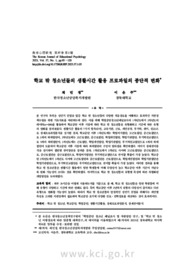

PARTNER
검증된 파트너 제휴사 자료
학교 밖 청소년들의 생활시간 활용 프로파일의 종단적 변화 (The Longitudinal Changes in Profile of Time Utilization among the Out-of-School Adolescents)
26 페이지
최초등록일 2025.05.06
최종저작일
2023.03

-
미리보기
서지정보
· 발행기관 : 한국교육심리학회
· 수록지 정보 : 교육심리연구 / 37권 / 1호 / 95 ~ 120페이지
· 저자명 : 채민정, 이은주
초록
본 연구의 목적은 성인기 진입을 앞둔 학교 밖 청소년들의 다양한 적응경로를 이해하고 효과적인 지원정책수립을 위한 기초자료를 마련하는데 있다. 이를 위해 학업중단청소년패널조사의 1차년도에서 3차년도의 데이터(n=398)를 활용하여 학교중단 이후 시점에 따라 학교 밖 청소년들을 유형화하고 시간에 따른 유형의 변화를 살펴보았다. 생활시간 활용의 7가지 항목(수면, 교육기관, 근로, 개인공부, 무기력, 취미, 친교)으로 잠재프로파일분석을 실시한 결과, 학교중단 이후 1차년도에는 학업여가집단, 고근로집단, 중근로집단으로 3개의 하위집단이, 2차년도에는 고근로집단, 중근로집단, 학업개인집단, 학업기관집단, 무기력친교집단으로 5개의 하위집단이, 3차년도에는 근로집단, 학업개인집단, 학업기관집단, 무기력친교집단으로 4개의 하위집단이 도출되어 학교중단 이후 시점에 따라 하위집단의 구성이 달라짐을 확인하였다. 이어서 잠재전이분석을 실시하여 집단별 전이양상을 살펴본 결과, 1차년도에서 2차년도 사이에 고근로집단은 중근로집단으로, 중근로집단은 중근로집단으로, 학업여가집단은 무기력친교집단으로 전이할 확률이 가장 높았다. 학교중단 2차년도에서 3차년도 사이에 고근로집단과 중근로집단은 근로집단으로, 학업개인집단과 학업기관집단은 학업기관집단으로, 무기력친교집단은 무기력친교집단으로 전이할 확률이 가장 높았다. 이러한 결과를 통해 학교 밖 청소년들은 생활시간 활용에서 일반 학생들에 비해 다양성이 높고 학교중단 이후 시간이 지날수록 변화 가능성이 크다는 것을 확인하였다. 마지막으로 학교 밖 청소년들의 유형별 특성에 따른 차별화된 개입방안을 논의하였다.
교육적 함의 : 하루 24시간을 어떻게 사용하는지를 기준으로 볼 때, 학교 밖 청소년들은 일반 학생들에 비해 유형이 다양하고 시간에 따른 변화도 컸다. 특히 학교중단 이후 2년까지 유형의 다양성이 증가하고 다른 유형으로 변화할 가능성이 높았다. 따라서 학교 밖 청소년들의 안정적인 성인기 진입을 위해서는 개인별 특성을 고려한 지원정책이 필요하며 학교중단 초기에 다양한 진로․진학정보를 제공하는 것이 효과적이다.영어초록
This study aimed to understand the various adaptation pathways of out-of-school adolescents about to enter adulthood to classify them according to the ways of utilizing their time and examine the changes over time. For this, seven items(sleep, educational institutions, work, personal study, lethargy, hobbies, and friendship) were selected from the data of the first year to the third year of the Academic Interruption Youth Panel Survey(n=398), to determine the ways of time utilization. Based on the analysis, the adolescents in the first year after dropping out of school were divided into three subgroups, i.e., academic-leisure group, high-working group, and medium-working group. For those in the second year, five subgroups were identified, i.e., high-working group, medium-working group, and self-education group, academic-institution group, and helpless-hanging out group. Furthermore, for those in the third year, four subgroups were identified, i.e., working group, self-education group, academic-institution group, and helpless-hanging out group. Subsequently, a latent transition analysis revealed that, from the first year to the second year, the high-working group had the highest probability of transitioning to the medium-working group, and the medium-working group had the highest probability of transitioning to the medium-working group, and the academic-leisure group had the highest probability of transitioning to the helpless-hanging out group. From the second year to the third year, the high-working group and medium-working group had the highest probability of transitioning to the working group, and the self-education group and academic-institution group had the highest probability of transitioning to the academic-institution group, and the helpless-hanging out group had the highest probability of transitioning to the helpless-hanging out group. These results confirmed that out-of-school adolescents' patterns of utilizing their time were more diverse and more likely to change over time than those of general students‘. Different intervention methods according to the characteristics of each type were discussed.
Educational Implications : Upon investigating how the 24 hours of a day are utilized, out-of-school adolescents displayed more diverse ways than general students, and the change over time was significant. The diversity increased up to two years after dropping out from school and the ways of utilizing their time were highly likely to change. For out-of-school adolescents to enter efficiently into adulthood, it is necessary to provide policy support that considers individual characteristics and information on various careers and advancement in the early stages after dropping out of school.참고자료
· 없음태그
-
자주묻는질문의 답변을 확인해 주세요

꼭 알아주세요
-
자료의 정보 및 내용의 진실성에 대하여 해피캠퍼스는 보증하지 않으며, 해당 정보 및 게시물 저작권과 기타 법적 책임은 자료 등록자에게 있습니다.
자료 및 게시물 내용의 불법적 이용, 무단 전재∙배포는 금지되어 있습니다.
저작권침해, 명예훼손 등 분쟁 요소 발견 시 고객센터의 저작권침해 신고센터를 이용해 주시기 바랍니다. -
해피캠퍼스는 구매자와 판매자 모두가 만족하는 서비스가 되도록 노력하고 있으며, 아래의 4가지 자료환불 조건을 꼭 확인해주시기 바랍니다.
파일오류 중복자료 저작권 없음 설명과 실제 내용 불일치 파일의 다운로드가 제대로 되지 않거나 파일형식에 맞는 프로그램으로 정상 작동하지 않는 경우 다른 자료와 70% 이상 내용이 일치하는 경우 (중복임을 확인할 수 있는 근거 필요함) 인터넷의 다른 사이트, 연구기관, 학교, 서적 등의 자료를 도용한 경우 자료의 설명과 실제 자료의 내용이 일치하지 않는 경우
“교육심리연구”의 다른 논문도 확인해 보세요!
-
다문화 청소년의 한국어 능력, 자아존중감, 어머니의 한국어 능력, 교우관계 간의 종단적 상호 인과관계 28 페이지
본 연구는 다문화 청소년의 한국어 능력, 자아존중감, 어머니의 한국어 능력, 교우관계의 변화양상과 종단적 상호 인과관계를 탐색하고자 하였다. 이를 위하여 다문화 청소년 패널(Multicultural Adolescents Panel Study: MAPS) 자료 중 1차년도(초4)부터 5차년도(중2)까지의 데이터를 활용하여 자기회귀교차지연모형 검증을 실시하였다.. -
초등학생의 동기 강화 자기조절전략개발(SRSD) 쓰기 프로그램 효과 24 페이지
본 연구는 동기부여에 초점을 두고 쓰기 전략과 자기조절 전략을 명시적으로 가르치는 프로그램을 개발하고, 프로그램이 학생의 쓰기와 학습동기에 미치는 효과를 검증하는 데 목적을 두었다. 이를 위해 본 연구는 ‘동기 강화 SRSD’ 쓰기 프로그램「생각노트 더 주세요.+」를 개발하고, 초등학교 6학년 일반 학급(53명)을 대상으로 SRSD 쓰기 프로그램「생각노트 .. -
초등교사가 인식하는 교육사각지대학습자 강점: 의미망 분석 중심으로 16 페이지
본 연구는 교사의 보고를 기반으로 하여 교육사각지대학습자의 일상 속 다양한 강점을 발견하고, 강점이 발견되는 상황적 맥락을 파악하고자 하였다. 이를 위해 현재 초등학교에 재직 중이며 담임교사인 443명을 대상으로 반구조화 질문지를 통해 설문을 실시하였다. 이후 교사가 인식하는 교육사각지대학습자의 특성을 자유롭게 도출한 후 텍스트 네트워크 분석방법 중 동시출..
문서 초안을 생성해주는 EasyAI
